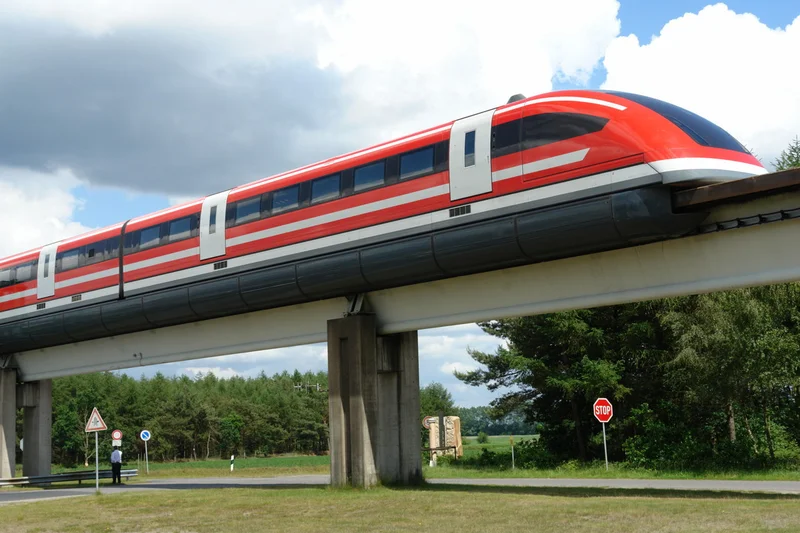Hyperloop Hype Train: Reality Check
The race to revolutionize transportation is heating up, with hyperloop systems and maglev trains vying for dominance. But before we get carried away by visions of zipping across continents in vacuum tubes, let's inject some data into the discussion. Because if there's one thing I've learned from staring at spreadsheets all day, it's that reality rarely matches the marketing.
Speed vs. Reality: A Numbers Game
India recently completed a 422-meter hyperloop test track, and plans are in motion for a nearly 50 km facility designed to hit speeds of 1,100 km/h. Meanwhile, China claims to have accelerated a maglev train to 650 km/h in just 7 seconds on a 1,000-meter track. Japan's SCMaglev technology has even reached a blistering 603 km/h in trials, with the goal of connecting Tokyo and Nagoya by 2030.
But let's pump the brakes for a second. These numbers, while impressive, need context. A 422-meter test track tells us virtually nothing about the scalability or cost-effectiveness of a full-scale hyperloop system. And achieving 650 km/h for a few seconds on a 1,000-meter track is a far cry from maintaining that speed over hundreds of kilometers with passengers on board. It's like saying you can run a four-minute mile because you sprinted 100 meters in 15 seconds. Doesn't quite work that way, does it?
Even the seemingly more advanced Japanese SCMaglev faces hurdles. Connecting Tokyo and Nagoya by 2030 is an ambitious goal, but the project has already faced delays and cost overruns (estimated to be in the tens of billions of dollars). And speaking of cost, that's where things get really interesting.
The Cost Question: Where's the ROI?
While the press releases tout groundbreaking speeds and futuristic technology, they often conveniently omit the financial realities. TransPod, for example, is building a test facility in Canada with C$3.9 billion in government investment. That's a hefty sum for a system aiming for speeds of "only" 300 km/h (still decent, but hardly revolutionary). What is the projected ROI on a project like this? What are the long-term maintenance costs? These are the questions that keep me up at night (metaphorically speaking, of course; I sleep quite well).
And this is the part of the analysis that I find genuinely puzzling: the lack of transparency regarding long-term costs and potential revenue streams. We're talking about massive infrastructure projects that will require billions of dollars in investment and decades of operation. Yet, the public discourse is dominated by talk of speed and innovation, with little attention paid to the fundamental economics.

The Shanghai Transrapid, which operates at 430 km/h, is often cited as a success story. But it's worth remembering that it relies on technology from Germany's Emsland test track, which closed in 2011. Why did it close? Because it wasn't economically viable.
NEVOMO is developing passive maglev technology for existing rail tracks in Poland, targeting speeds up to 550 km/h. This approach seems more pragmatic, as it leverages existing infrastructure. But even here, the long-term economic viability remains an open question.
The Virgin Hyperloop Curveball
Perhaps the most telling development is Virgin Hyperloop's shift in focus. After completing its first (and only) human trial in Nevada in 2020 (reaching a modest 172 km/h), the company is now prioritizing freight. This is a significant pivot. Hauling cargo is a much less risky (and likely more profitable) proposition than transporting human passengers at breakneck speeds. It suggests that the original vision of a hyperloop revolution may have been a bit… optimistic.
Details on why the decision was made remain scarce, but the impact is clear. The company has significantly scaled back its ambitions and is now focusing on a more niche market. It's a classic case of a company adjusting its strategy in response to market realities.
Data Without the Hype
So, where does this leave us? The hyperloop and maglev train technologies are undoubtedly impressive. Several countries are currently testing these next-generation hyper-speed trains 10 countries testing the next generation of hyper-speed trains - WION. But the path to widespread adoption is fraught with challenges, both technical and economic. The speeds are eye-catching, but the costs are astronomical, and the long-term viability remains uncertain. Until we see more concrete data on cost-effectiveness and ROI, I'll remain firmly in the skeptical camp.
